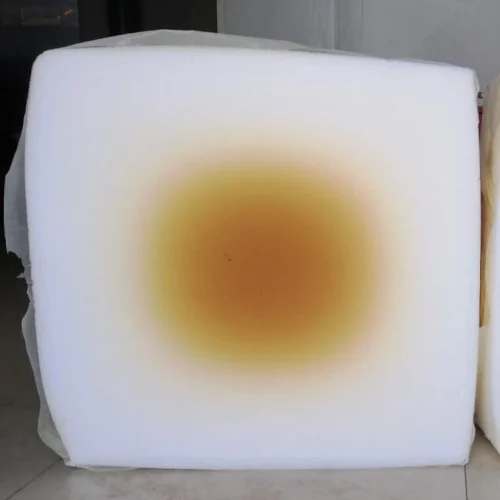This article examines how to handle sponge core burning by modifying formulas, focusing on external factors such as raw materials.
- Polyether Reactivity
Polyether is the primary component in foam production. Taking standard sponge polyether as an example: it has a molecular weight of 3000 and a hydroxyl value of 56. There are two types of polyether commonly used in sponge production:
·Full PO: Made entirely from propylene oxide (PO).
·Partial EO: Contains some ethylene oxide (EO), which has higher reactivity than PO.
If a formula using full PO polyether switches to partial EO polyether, the reactivity increases. Consequently, the T9 catalyst dosage should be reduced by 15%. Adjusting T9 ensures the reaction rate and heat release are balanced, which minimizes any noticeable impact of polyether reactivity on core burning. This adjustment happens subconsciously in formula development.
- Adding Calcium Carbonate
Calcium carbonate, an inorganic filler, does not participate in the reaction but instead impedes it, thereby slowing down heat release. Consider a formula using partial EO polyether:
·If switching from a formula without calcium carbonate to one containing it, the calcium carbonate content should increase by over 10% for full PO formulas.
·For comparison, when calcium carbonate is added, the internal foam temperature is consistently lower because the reaction is hindered.
To align the reaction rate of a modified formula with the original:
·Adjust water content from 4.2 to 4.3.
·Set MC to 10.
·Fine-tune A33 to 0.26 or 0.27.
Avoid altering amine levels excessively, as this could destabilize the formula.
- Adding Flame Retardants
Flame retardants, which are acidic, catalyze the water-TDI reaction, the primary heat-releasing reaction that produces CO₂. For low-density sponges, this reaction may account for over 70% of total heat release. With faster heat generation:
·Internal foam temperature rises.
·The likelihood of core burning increases.
For Formula 2 (with flame retardants):
·Internal temperature is higher than in Formula 1, making Formula 2 more prone to core burning.
Adjustments:
·Reduce water content to 4.1.
·Increase MC to 12.
·Lower A33 to approximately 0.24.
- TDI Index
Using Formula 3 as a case study:
·At a TDI index of 58, tin catalyst dosage is 0.275.
·At a TDI index of 60, tin catalyst dosage drops to 0.265.
As the TDI index increases:
·Excess TDI leads to more heat release.
·The water-TDI reaction slows down, reducing heat output but accelerating secondary reactions involving residual TDI.
It’s challenging to determine whether the internal temperature will be higher at TDI 58 or TDI 60 due to the interplay of these effects.

